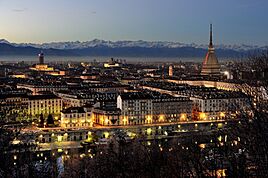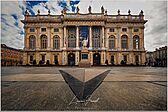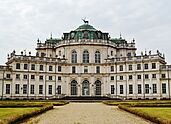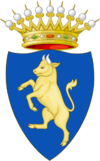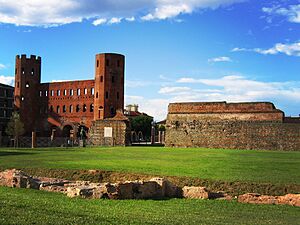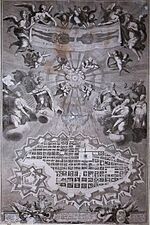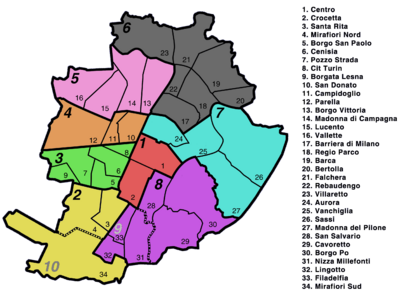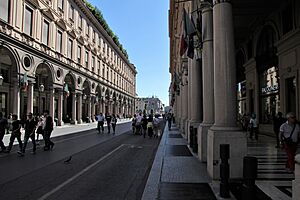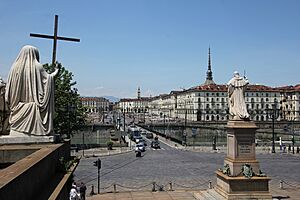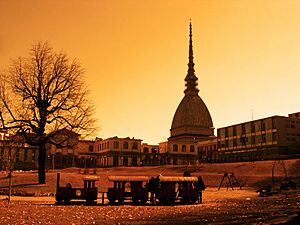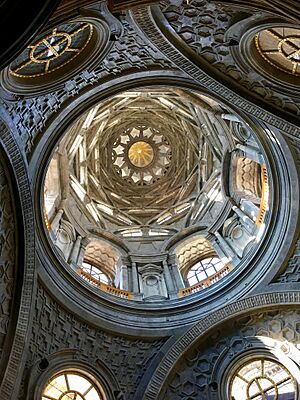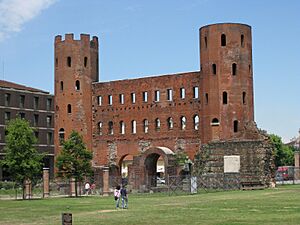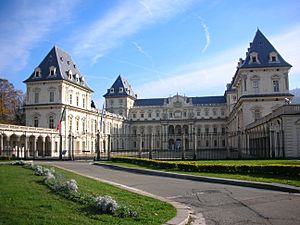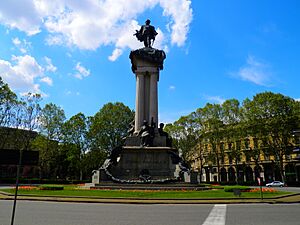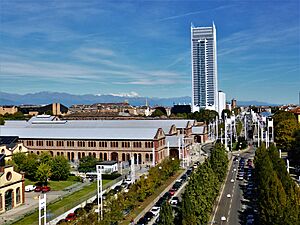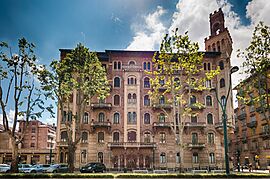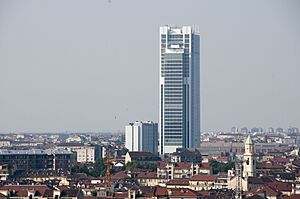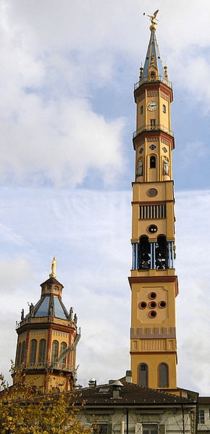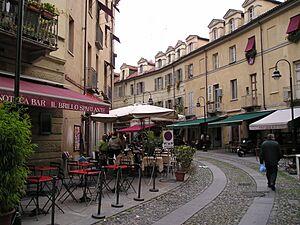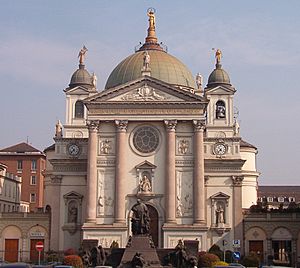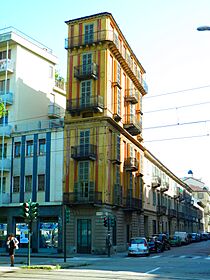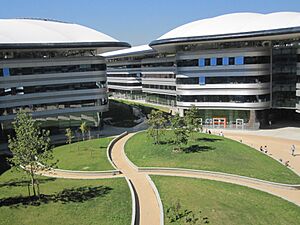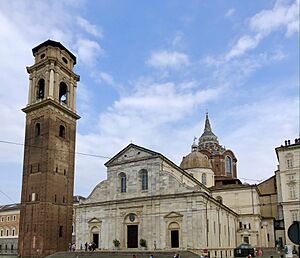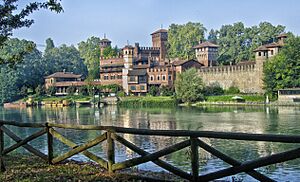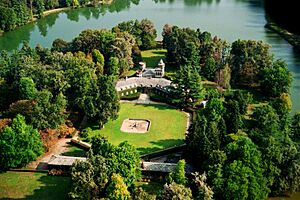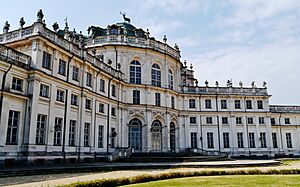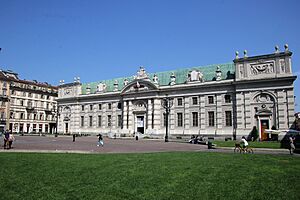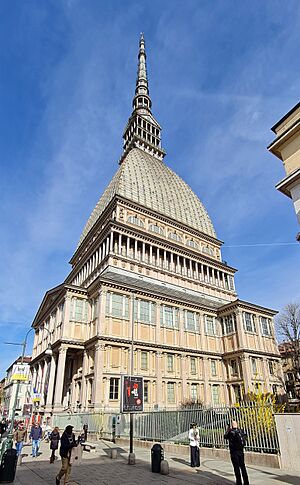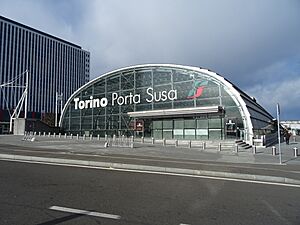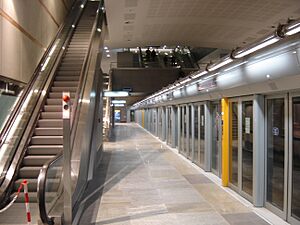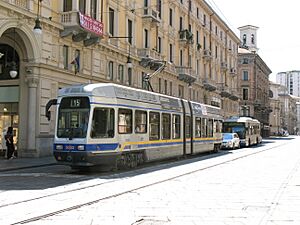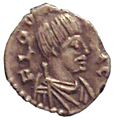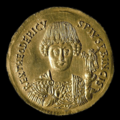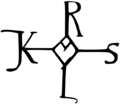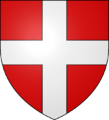Turin facts for kids
Quick facts for kids
Turin
Torino (Italian)
|
|||
|---|---|---|---|
| Città di Torino | |||
|
Skyline of Turin
Borgo Medioevale
Mole Antonelliana
Palazzo Madama
Palazzina di caccia of Stupinigi
Chapel of the Holy Shroud
|
|||
|
|||
| Nickname(s): | |||
| Motto(s): | |||
 |
|||
| Country | Italy | ||
| Region | Piedmont | ||
| Area | |||
| • Total | 130.01 km2 (50.20 sq mi) | ||
| Elevation | 239 m (784 ft) | ||
| Population
(2025)
|
|||
| • Total | 856,745 | ||
| • Density | 6,589.84/km2 (17,067.6/sq mi) | ||
| Demonym(s) | Turinese(s) | ||
| Time zone | UTC+1 (CET) | ||
| • Summer (DST) | UTC+2 (CEST) | ||
| Postal code |
10121-10156
|
||
| Dialing code | 0039 011 | ||
| Patron saint | John the Baptist | ||
| Saint day | 24 June | ||
| UNESCO World Heritage Site | |||
| Official name | Residences of the Royal House of Savoy | ||
| Includes | several locations in Turin | ||
| Criteria | Cultural: (i)(ii)(iv)(v) | ||
| Inscription | 1997 (21st Session) | ||
| Extensions | 2010 | ||
Turin is a big city and an important center for business and culture in northern Italy. It is the capital city of Piedmont and was the first capital of Italy from 1861 to 1865. The city sits mostly on the western bank of the River Po, surrounded by the western Alpine arch and Superga hill. In 2025, Turin had a population of 856,745 people.
Turin has a rich history and was once a major political center in Europe. From 1563, it was the capital of the Duchy of Savoy and then the Kingdom of Sardinia. It is sometimes called "the cradle of Italian liberty" because it was a key place for the Risorgimento, the movement that led to Italy becoming one united country.
Today, Turin is a big hub for industry, business, and trade. It is part of an important industrial area with Milan and Genoa. The city is also home to a large part of the Italian automotive industry, with headquarters for companies like Fiat, Lancia, and Alfa Romeo.
Turin is known for its many art galleries, restaurants, churches, palaces, and museums. It features beautiful Baroque, Rococo, Neoclassical, and Art Nouveau buildings. Many of its elegant squares and palaces, like the Palazzo Madama, were built between the 16th and 18th centuries. Some of these, like the Residences of the Royal House of Savoy, are even UNESCO World Heritage Sites.
The city also has famous museums, such as the Museo Egizio (Egyptian Museum), and the Mole Antonelliana, which is a symbol of Turin and hosts the National Museum of Cinema. Turin is a popular place for tourists. It also has some of Italy's best universities, like the University of Turin and the Turin Polytechnic. Famous things from Turin include the Shroud of Turin, the gianduiotto chocolate, the Fiat car brand, and the football club Juventus. Turin hosted the 2006 Winter Olympics, the Eurovision Song Contest 2022, and the tennis ATP Finals from 2021 to 2025.
Contents
History
Ancient Beginnings
Long ago, the Taurini people lived in the area where Turin is now. In 218 BC, they were attacked by Hannibal. Later, around 28 BC, the Romans built a colony here called Julia Augusta Taurinorum, which is modern Turin.
Roman Times
In the 1st century BC, the Romans officially founded Augusta Taurinorum. You can still see parts of the Roman city today. For example, Via Garibaldi follows the path of the old Roman main street. The Porta Palatina, an ancient Roman gate, is still standing near the cathedral. At that time, about 5,000 people lived inside the city walls.
Middle Ages
After the Western Roman Empire fell, Turin was ruled by different groups, including the Ostrogoths and Lombards. In 773, the Franks took control under Charlemagne. The House of Savoy family gained control in 1046. By the end of the 13th century, Turin had grown to 20,000 people. Many gardens and palaces were built in the 15th century, and the University of Turin was also founded then.
Early Modern Era
In 1563, Emmanuel Philibert made Turin the capital of the Duchy of Savoy. New squares and streets were added, and the Royal Palace of Turin was built. In 1706, during the Battle of Turin, the French army tried to capture the city but failed after a long siege. Turin then became the capital of the Kingdom of Sardinia. A famous architect named Filippo Juvarra helped redesign the city.
Recent History
In 1802, Turin became part of the French Empire under Napoleon. After Napoleon's fall in 1814, the Kingdom of Piedmont-Sardinia was restored. This kingdom played a big role in uniting Italy. In 1861, Turin became the first capital of the new Kingdom of Italy. The capital later moved to Florence and then to Rome.
The late 1800s saw fast growth in industry, especially cars. Fiat was started in Turin in 1899, followed by Lancia in 1906. Turin hosted big international events in 1902 and 1911. By then, the city had 430,000 people.
After World War I, there were many strikes and protests. During Fascist rule, the car industry was supported. Turin was heavily bombed during World War II because of its factories. The city was freed by Italian fighters in April 1945.
After the war, Turin was quickly rebuilt. Its car industry helped create Italy's "economic miracle" in the 1950s and 1960s. Many people moved to Turin from southern Italy, and the population grew to almost 1.2 million by 1971. Turin was called the "Automobile Capital." Later, the city faced challenges in the 1970s and 1980s, and its population decreased. However, it has started to grow again recently. In 2006, Turin hosted the 2006 Winter Olympics.
Geography
Turin is in northwest Italy. It is surrounded by the Alps mountains to the west and north. To the east, there is a high hill that connects to the Monferrato hills. Four main rivers flow through the city: the Po River and three of its smaller rivers, the River Dora Riparia, the Stura di Lanzo, and the Sangone.
Climate
Turin has a climate with four seasons. Winters are usually cold and dry, while summers are warm in the hills and quite hot in the flat areas. Most rain falls in spring and autumn. During summer, rain is less common but can be very heavy, with thunderstorms. Fog can form in the flat areas during winter and autumn, but it is rare in the city itself because of its location. Snow is not unusual in winter, but heavy snowfalls are rare.
The highest temperature ever recorded was 37.1°C (98.8°F) on August 11, 2003. The lowest was -21.8°C (-7.2°F) on February 12, 1956.
| Climate data for Torino Caselle Airport, (1991–2020 normals, extremes 1946–present) | |||||||||||||
|---|---|---|---|---|---|---|---|---|---|---|---|---|---|
| Month | Jan | Feb | Mar | Apr | May | Jun | Jul | Aug | Sep | Oct | Nov | Dec | Year |
| Record high °C (°F) | 25.1 (77.2) |
26.6 (79.9) |
27.4 (81.3) |
31.0 (87.8) |
32.3 (90.1) |
35.6 (96.1) |
36.8 (98.2) |
37.1 (98.8) |
32.7 (90.9) |
30.0 (86.0) |
22.8 (73.0) |
21.4 (70.5) |
37.1 (98.8) |
| Mean daily maximum °C (°F) | 8.0 (46.4) |
10.2 (50.4) |
14.8 (58.6) |
18.0 (64.4) |
22.2 (72.0) |
26.4 (79.5) |
29.0 (84.2) |
28.6 (83.5) |
23.9 (75.0) |
18.1 (64.6) |
12.2 (54.0) |
8.3 (46.9) |
18.3 (65.0) |
| Daily mean °C (°F) | 3.3 (37.9) |
4.9 (40.8) |
9.2 (48.6) |
12.6 (54.7) |
16.9 (62.4) |
21.0 (69.8) |
23.2 (73.8) |
22.8 (73.0) |
18.6 (65.5) |
13.5 (56.3) |
7.9 (46.2) |
3.8 (38.8) |
13.1 (55.7) |
| Mean daily minimum °C (°F) | −1.5 (29.3) |
−0.3 (31.5) |
3.7 (38.7) |
7.2 (45.0) |
11.6 (52.9) |
15.5 (59.9) |
17.4 (63.3) |
17.1 (62.8) |
13.3 (55.9) |
8.9 (48.0) |
3.5 (38.3) |
−0.7 (30.7) |
8.0 (46.4) |
| Record low °C (°F) | −18.5 (−1.3) |
−21.8 (−7.2) |
−10.5 (13.1) |
−3.8 (25.2) |
−2.3 (27.9) |
4.3 (39.7) |
6.6 (43.9) |
6.3 (43.3) |
1.8 (35.2) |
−3.9 (25.0) |
−8.2 (17.2) |
−13.8 (7.2) |
−21.8 (−7.2) |
| Average precipitation mm (inches) | 47.8 (1.88) |
47.1 (1.85) |
72.5 (2.85) |
113.3 (4.46) |
145.3 (5.72) |
104.3 (4.11) |
70.5 (2.78) |
76.1 (3.00) |
83.8 (3.30) |
106.1 (4.18) |
69.1 (2.72) |
45.1 (1.78) |
981.0 (38.62) |
| Average precipitation days (≥ 1.0 mm) | 5.4 | 4.4 | 5.8 | 8.6 | 11.2 | 8.6 | 5.8 | 7.7 | 6.4 | 7.0 | 5.6 | 4.4 | 80.9 |
| Average relative humidity (%) | 75 | 75 | 67 | 72 | 75 | 74 | 72 | 73 | 75 | 79 | 80 | 80 | 75 |
| Mean monthly sunshine hours | 111.6 | 118.7 | 158.1 | 180.0 | 195.3 | 219.0 | 260.4 | 223.2 | 168.0 | 142.6 | 105.0 | 108.5 | 1,990.4 |
| Source 1: Istituto Superiore per la Protezione e la Ricerca Ambientale | |||||||||||||
| Source 2: Italian Air Force Meteorological Service (precipitation, humidity and sun 1971–2000) | |||||||||||||
City Administration
Turin is divided into 8 areas called circoscrizioni. These areas do not always match the older, historical parts of the city. The mayor of Turin is chosen every five years. The current mayor is Stefano Lo Russo, who was elected in 2021.
Cityscape
City Center
Turin's old buildings are mostly in the Baroque style. This style was popular when the Savoy family ruled. The main street, Via Roma, was built in the 1930s. It shows a style called Italian Rationalism.
Via Roma connects Piazza Carlo Felice and Piazza Castello. The buildings along this street have covered walkways, which are great for shopping. Today, Via Roma has the most fashionable shops in the city.
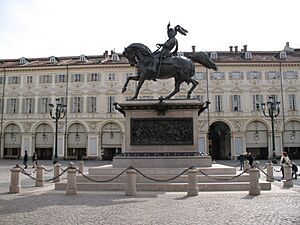
One of the main squares is Piazza San Carlo, built in the 17th century. In the middle, there is a statue of Emmanuel Philibert on a horse. This statue is known as Caval ëd Brons (Bronze Horse). The square's covered walkways are home to some of the oldest cafes in Turin.
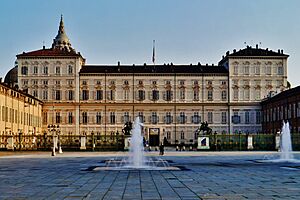
At the end of Via Roma is Piazza Castello, the heart of the city. Here you can find important buildings like the Palazzo Reale (Royal Palace) and the Palazzo Madama. The square also has the Royal Library of Turin, which holds a famous self-portrait by Leonardo da Vinci. Piazza Castello is often used for big events and concerts.
Via Roma ends at Piazza Carlo Felice, where you can see the grand Porta Nuova railway station. This station was built between 1861 and 1868. It has a grand entrance and a beautiful old waiting room called the Sala Reale.
From Piazza Castello, another important street is Via Po. It has covered walkways and old buildings, including the first building of the University of Turin. Via Po leads to Piazza Vittorio Veneto, which is one of the largest Baroque squares in Europe. This square is a popular spot for Turin's nightlife.

Two other popular streets, Via Lagrange and Via Carlo Alberto, run parallel to Via Roma. They have many shops and luxury boutiques. Via Lagrange is home to the Egyptian Museum of Turin, which has one of the world's largest collections of ancient Egyptian items outside of Egypt.
Via Lagrange crosses Piazza Carignano, known for the wavy Baroque design of Palazzo Carignano. This building once housed the Italian Parliament and now holds the Museum of the Risorgimento.
Near Via Po is the Mole Antonelliana, a symbol of Turin. It was designed by Alessandro Antonelli and started as a Jewish synagogue. Today, it is home to the National Museum of Cinema and is thought to be the tallest museum in the world.
Behind Piazza Castello is the Turin Cathedral, dedicated to Saint John the Baptist. It was built between 1491 and 1498. Attached to the cathedral is the Chapel of the Holy Shroud, where the famous Shroud of Turin is kept.
Next to the cathedral are the Palatine Towers, old Roman-medieval structures that were once city gates. They are among the best-preserved Roman ruins in northern Italy. Nearby, Piazza della Repubblica hosts Europe's biggest open-air market.
West of the Palatine Towers is the Quadrilatero Romano, an old medieval area. It has narrow streets and old buildings. Today, it is popular for its cafes and small artisan shops.
San Salvario District
Southeast of the city center is the San Salvario district. This area is known for its diverse community and lively nightlife with many affordable bars and restaurants.
The famous Parco del Valentino is in the eastern part of San Salvario. It is a popular park for locals, both during the day and at night. In the park, you can find the Castello del Valentino, built in the 17th century. This castle is now part of the Polytechnic University of Turin. Another interesting part of the park is the Borgo Medioevale (Medieval village), which is a copy of medieval mountain castles.
Crocetta District
South of the city center is the Crocetta district, known for its nice residential buildings. The area has many beautiful buildings in eclectic, neo-Gothic, and Art Nouveau styles.
The GAM (Galleria d'Arte Moderna) is one of Turin's modern art museums. It stands near a large monument to King Vittorio Emanuele II. The main building of the Polytechnic University of Turin is also in this district. It is one of the country's major technology institutes.
Crocetta has wide, modern avenues with many trees. Corso De Gasperi is popular for its open-air market, where you can find discounted clothing.
Cenisia District
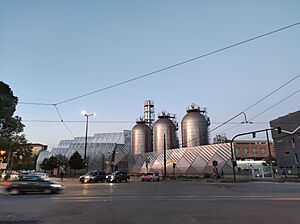
This district is important because it hosts the newer parts of the Politecnico. The university expanded into this area after old railway buildings were removed. This area now includes a General Motors research center.
The main building of the former Officine Grandi Riparazioni (OGR), which were old train maintenance facilities, has become a large open space for exhibitions and events. North of the OGR is Le Nuove, a former prison complex that is now a museum.
Cit Turin District
Cit Turin means 'Little Turin' in the local language. It is the smallest district and is considered a fancy residential area. It has many buildings in Art Nouveau, Art Deco, and Neo-Gothic styles. Two famous examples are the Casa della Vittoria and Casa Fenoglio-Lafleur.
The district is known for its shops, especially on Via Duchessa Jolanda and Via Principi d'Acaja. It also has two large modern buildings: the Palazzo di Giustizia (Turin's new courthouse) and the Torre Intesa Sanpaolo, which is one of Turin's first skyscrapers.
San Donato District
The San Donato district grew in the 19th century. Its main church, Chiesa di Nostra Signora del Suffragio e Santa Zita, has a tall bell tower, which is the fifth tallest structure in Turin.
The district has many historic buildings in Art Nouveau style. Among the modern buildings, the Torre BBPR Tower is notable. The northern part of the district was once an industrial area but has been turned into a park called Parco Dora.
Aurora District
Aurora is one of the oldest districts outside the city walls. Its historical center is Borgo Dora, famous for its mercatino del Balon, a flea market held every Saturday. This area is very diverse, with many people from different countries living there.
Borgo Dora has several important places, including the Piccola Casa della Divina Provvidenza (a charity organization) and the Arsenale della Pace (a former weapons factory now helping people in need). There is also a hot air balloon that offers views of the city.
West of Borgo Dora is Rione Valdocco, which has the important Santuario di Maria Ausiliatrice church. The district is crossed by major roads like Corso Giulio Cesare.
The northern part of Aurora has a mix of old homes and former factories. The famous Lavazza coffee company built its new headquarters here. This area also has the oldest public housing in the city.
Vanchiglia District
Vanchiglia is a district near the city center. The historical part, Borgo Vanchiglia, is popular for its bars and restaurants, being close to Piazza Vittorio Veneto.
An unusual building here is the "Fetta di Polenta" (Polenta Slice), designed by Alessandro Antonelli. It is very thin and shaped like a slice of cake.
The Teatro della Caduta is the smallest theater in Turin. North of Corso Regina Margherita, the district changes. Old factories have been replaced by modern buildings, like the new Law Faculty building (Campus "Luigi Einaudi"), designed by Norman Foster. This building is considered one of the most spectacular university buildings in the world.
The Cimitero Monumentale is Turin's largest cemetery. It has many historical tombs and artistic sculptures.
Main Churches
The Santuario della Consolata is a popular church for pilgrims. Other important churches include the Basilica of Our Lady, Help of Christians and the Gran Madre.
On the hills overlooking the city, the Basilica of Superga offers amazing views of Turin and the Alps. This basilica holds the tombs of many dukes of Savoy and kings of Sardinia. It was built in 1706 to celebrate Turin's liberation.
Parks and Gardens
The most popular park in Turin is Parco del Valentino. In 1961, it hosted a big international flower exhibition. Turin has many other large parks like Parco della Pellerina and Parco Colletta. There are also many smaller parks in different districts, with a total of 240 playgrounds for children.
One famous park with a playground is Parco della Tesoriera. It also has the Andrea della Corte Municipal Music Library, located in Villa Tesoriera, an old residence built in 1715.
Population Facts
| Historical population | ||
|---|---|---|
| Year | Pop. | ±% |
| 1861 | 173,305 | — |
| 1871 | 210,873 | +21.7% |
| 1881 | 250,655 | +18.9% |
| 1901 | 329,691 | +31.5% |
| 1911 | 415,667 | +26.1% |
| 1921 | 499,823 | +20.2% |
| 1931 | 590,753 | +18.2% |
| 1936 | 629,115 | +6.5% |
| 1951 | 719,300 | +14.3% |
| 1961 | 1,025,822 | +42.6% |
| 1971 | 1,167,968 | +13.9% |
| 1981 | 1,117,154 | −4.4% |
| 1991 | 962,507 | −13.8% |
| 2001 | 865,263 | −10.1% |
| 2011 | 872,367 | +0.8% |
| 2021 | 848,748 | −2.7% |
| Source: ISTAT | ||
As of 2025, Turin has 856,745 people. This is less than its highest population of 1,167,968 in 1971. The city has seen many immigrants from southern Italy and other countries. About 13.5% of the population are foreigners, mainly from Romania, Morocco, and Albania. Turin has more older people than young people. About 18% of the population is under 20, while 22% is over 65.
| Nationality | Population (2020) |
|---|---|
| 49,644 (−1,590 units) | |
| 16,808 (+212 units) | |
| 7,511 (+3 units) | |
| 7,195 (−76 units) | |
| 5,489 (+72 units) | |
| 5,450 (+390 units) | |
| 5,360 (+15 units) | |
| 3,778 (−23 units) | |
| 3,331 (−244 units) | |
| 1,949 (+213 units) | |
| 1,901 (+84 units) | |
| 1,698 (+6 unit) | |
| 1,258 (+45 units) | |
| 1,204 (+197 units) | |
| 1,198 (+62 units) | |
| 1,173 (+16 units) | |
| 1,118 (−70 units) | |
| other countries | each <1000 |
Economy
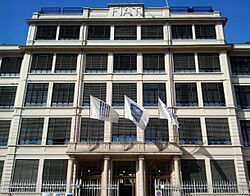
Turin's economy used to focus heavily on manufacturing, especially cars and aerospace. Even though the car industry has changed, it is still very important to the city. Many people in Turin work in the car industry, and most of Turin's exports are manufactured goods. Turin is home to Fiat, which is now part of Stellantis, one of the world's largest car companies.
Since the 1980s, Turin has also grown in other areas, like technology and innovation. It ranks high in Italy for new tech companies and patent applications. In 2008, Turin's economy was valued at $68 billion, making it one of the richest cities in Europe. Turin contributes about 8% to Italy's total economy.
Other important companies in Turin include Maserati, Lancia, Alfa Romeo, and Iveco (automotive). There are also companies like RAI (national broadcasting), Intesa Sanpaolo (finance), Kappa (fashion), Ferrero and Lavazza (food and drink).
Turin is also known for its aerospace industry, with companies like Alenia Aeronautica and Thales Alenia Space. Parts of the International Space Station, like the Harmony and Columbus modules, were made in Turin.
Culture
Art and Museums

As a former capital, Turin has many royal buildings. The 17th-century Royal Palace of Turin was the official home of the Savoy family. Other palaces and castles in and around Turin, like Palazzo Madama and Valentino Castle, are part of the Residences of the Royal House of Savoy. These are UNESCO World Heritage Sites. Turin is also recognized by UNESCO as a "Design City."
The Egyptian Museum of Turin is famous for its large collection of ancient Egyptian items, one of the biggest outside of Egypt. The Museum of Oriental Art has important Asian art.
Other museums include the National Museum of Cinema (in the Mole Antonelliana) and the Museo Nazionale dell'Automobile (National Automobile Museum). Art museums include the Sabauda Gallery and the Gallery of Modern and Contemporary Art.
Many famous artists and architects, like Carlo di Castellamonte and Filippo Juvarra, worked in Turin when the Savoy family wanted to make it a major cultural city. In the 20th century, Turin became important for painting and visual arts, with artists like Felice Casorati and the Arte Povera movement.
Music
Turin's main opera house is Teatro Regio di Torino. The famous opera La bohème by Puccini was first performed here in 1896. The building burned down in 1936 but was rebuilt after World War II.
Turin hosted the Eurovision Song Contest 2022 at the Pala Alpitour. This was the first time Turin hosted the contest and the third time Italy hosted it.
Literature
Turin has been a literary center for centuries. In the 17th century, the writer Giambattista Marino lived here. Later, in the 19th century, Turin became important for the Italian unification movement, and many writers lived in the city.
After World War II, Turin played a very important role in Italian literature. A major publishing house, Giulio Einaudi, published works by famous authors like Cesare Pavese and Primo Levi. More recently, writers like Alessandro Baricco have been active in the city.
Religion
Turin is home to the famous Shroud of Turin. This linen cloth shows the image of a man who seems to have been crucified. Many Christians believe it is a miraculous image of Jesus. It is kept in the royal chapel of the Turin Cathedral and is a major symbol and tourist attraction for the city.
Science and Technology
Turin has a history of scientific discovery. The astronomer Giovanni Plana used an observatory here. The scientist Amedeo Avogadro was a professor in Turin. Galileo Ferraris, a professor at Turin University, discovered how electric motors work in the 19th century.
Media
In 2006, Turin was chosen by UNESCO as the World Book Capital. The Turin International Book Fair is one of the most important book fairs in Europe. Turin is also home to one of Italy's main national newspapers, La Stampa, and the sports newspaper Tuttosport. RAI, Italy's national broadcasting company, has had a production center in Turin since 1954.
Sport
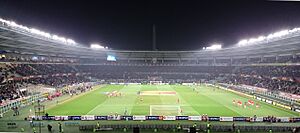
Turin has a rich sports history, especially with its two famous football teams: Juventus FC (founded in 1897) and Torino FC (founded in 1906). Juventus has fans all over Italy and the world, while Torino has strong support in the city itself. The two clubs play in the oldest local football match in Italy, called the Derby della Mole.
Juventus is Italy's most successful football club and one of the most successful in the world. It was the first club to win all possible official European club competitions and the world title. Juventus' home stadium, the Juventus Stadium, opened in 2011.
Torino FC was founded in 1906. Its team from the 1940s, called "Grande Torino", was very successful. Sadly, in 1949, almost the entire team died in a plane crash. Torino plays its home games at the Stadio Olimpico "Grande Torino".
Turin hosted the final stages of the EuroBasket 1979 (basketball). The city also hosted the 2006 Winter Olympics in February 2006. Turin was the largest city to host a Winter Olympics at that time. Turin was named the European Capital of Sport in 2015. The city has hosted the ATP Finals tennis event from 2021 to 2025. Turin will host the 2025 Special Olympics World Winter Games.
Cinema
Turin is where Italian cinema began. The first Italian film screening happened in Turin in March 1896. By the early 1900s, many early Italian films were shown in Turin. For example, Giovanni Pastrone's Cabiria (1914) was one of the first big movies in history.
Companies like Ambrosio Film helped make Turin an important place for filmmaking. Turin continued to be a major film center until 1937, when Cinecittà opened in Rome.
After World War II, Turin's film scene continued to do well. The National Museum of Cinema opened in 1956 and moved to the Mole Antonelliana in 2000. In 1982, the Torino Film Festival was created.
Today, Turin is still a main center for film and television in Italy. Many movies, TV shows, and commercials are produced here. Famous movies like The Italian Job and Hannah and Her Sisters were filmed in Turin.
Cuisine
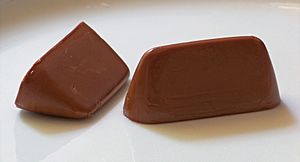
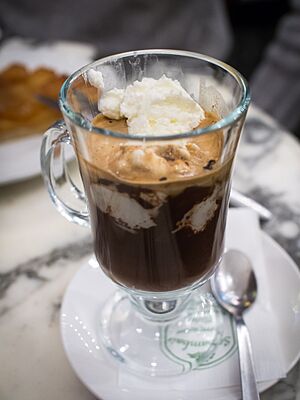
Turin is famous for its chocolate, especially the traditional gianduiotto, a chocolate shaped like a small ingot. The city is also known for bicerin, a hot drink made with espresso, chocolate, and milk. Every year, Turin holds CioccolaTÒ, a two-week chocolate festival.

The popular tramezzini sandwiches were first made in a Turin cafe in 1925. Another local drink is MoleCola, an Italian soda that started in 2012.
Turin also has a special type of pizza called pizza al padellino or pizza al tegamino. This is a small, thick-crust pizza served in a pan. The Slow Food movement, which promotes local and traditional food, also started in this region.
Education
Turin is home to one of Italy's oldest universities, the University of Turin. Another important university is the Polytechnic University of Turin, which is ranked among the top universities in the world for engineering and computer science. Turin also hosts the United Nations System Staff College and a campus of the ESCP business school.
In 2025, Turin became the first city in Italy to create a plan to fight against Islamophobia.
Transportation
Turin has been working on many transportation projects. One big project is the Spina Centrale (Central Spine), which involves covering a major railway line that crosses the city. Porta Susa is becoming Turin's main train station.
Another major project is the Metrotorino subway system. The first part of the subway opened for the 2006 Winter Olympics in 2006. It has been extended since then, and more extensions are planned for the future.
The city has an international airport called Caselle International Airport Sandro Pertini. It is about 13 kilometers (8 miles) from the city center and can be reached by train or bus.
From 2010 to 2023, a bicycle sharing system called ToBike was available. The city also has a metropolitan railway service.
Central areas of Turin are served by trams.
Public Transportation Use
On a typical weekday, people in Turin spend about 65 minutes traveling on public transport. About 14% of riders travel for more than 2 hours each day. The average wait time at a stop is 14 minutes, with 19% of riders waiting over 20 minutes. The average distance traveled in one trip is 5.9 kilometers (3.7 miles).
Notable People
International Connections
Twin Cities
Turin is twinned with several cities around the world:
- Chambéry, France
- Cologne, Germany
- Córdoba, Argentina
- Detroit, United States
- Esch-sur-Alzette, Luxembourg
- Glasgow, Scotland
- Liège, Belgium
- Lille, France
- Nagoya, Japan
- Quetzaltenango, Guatemala
- Rosario, Argentina
- Rotterdam, Netherlands
- Salt Lake City, United States
- Shenyang, China
Cooperation Agreements
Turin also has cooperation agreements with these cities:
- Bacău, Romania
- Barcelona, Spain
- Bethlehem, Palestine
- Campo Grande, Brazil
- Cannes, France
- Fortaleza, Brazil
- Haifa, Israel
- Harbin, China
- Ho Chi Minh City, Vietnam
- Kharkhorin, Mongolia
- Lyon, France
- Marseille, France
- Nantes, France
- Nice, France
- Praia, Cape Verde
- Rosario, Argentina
- Saint Petersburg, Russia
- Salvador, Brazil
- Skopje, North Macedonia
- Shenzhen, China
- Yangon, Myanmar
- Yekaterinburg, Russia
- Zlín, Czech Republic
Images for kids
See also
 In Spanish: Turín para niños
In Spanish: Turín para niños


